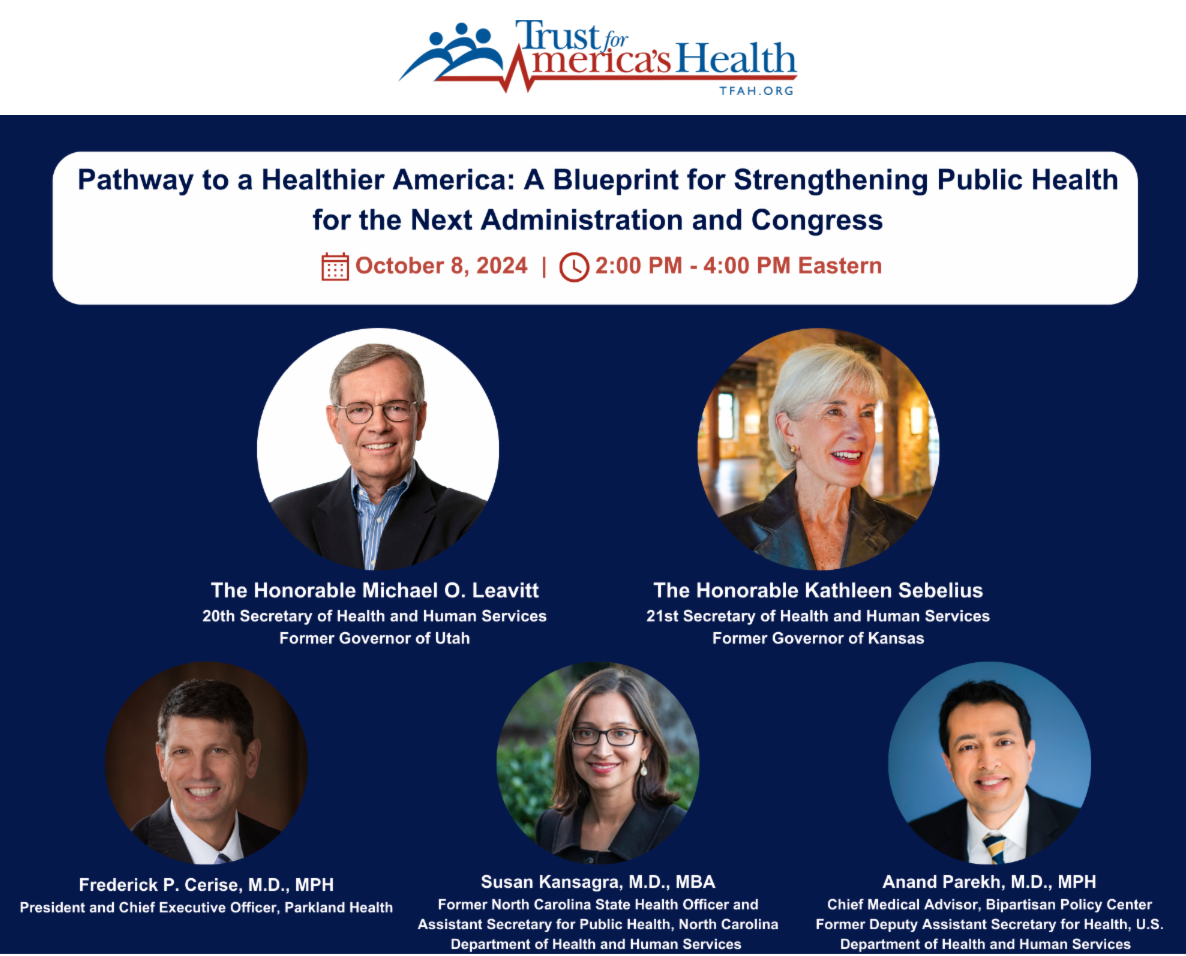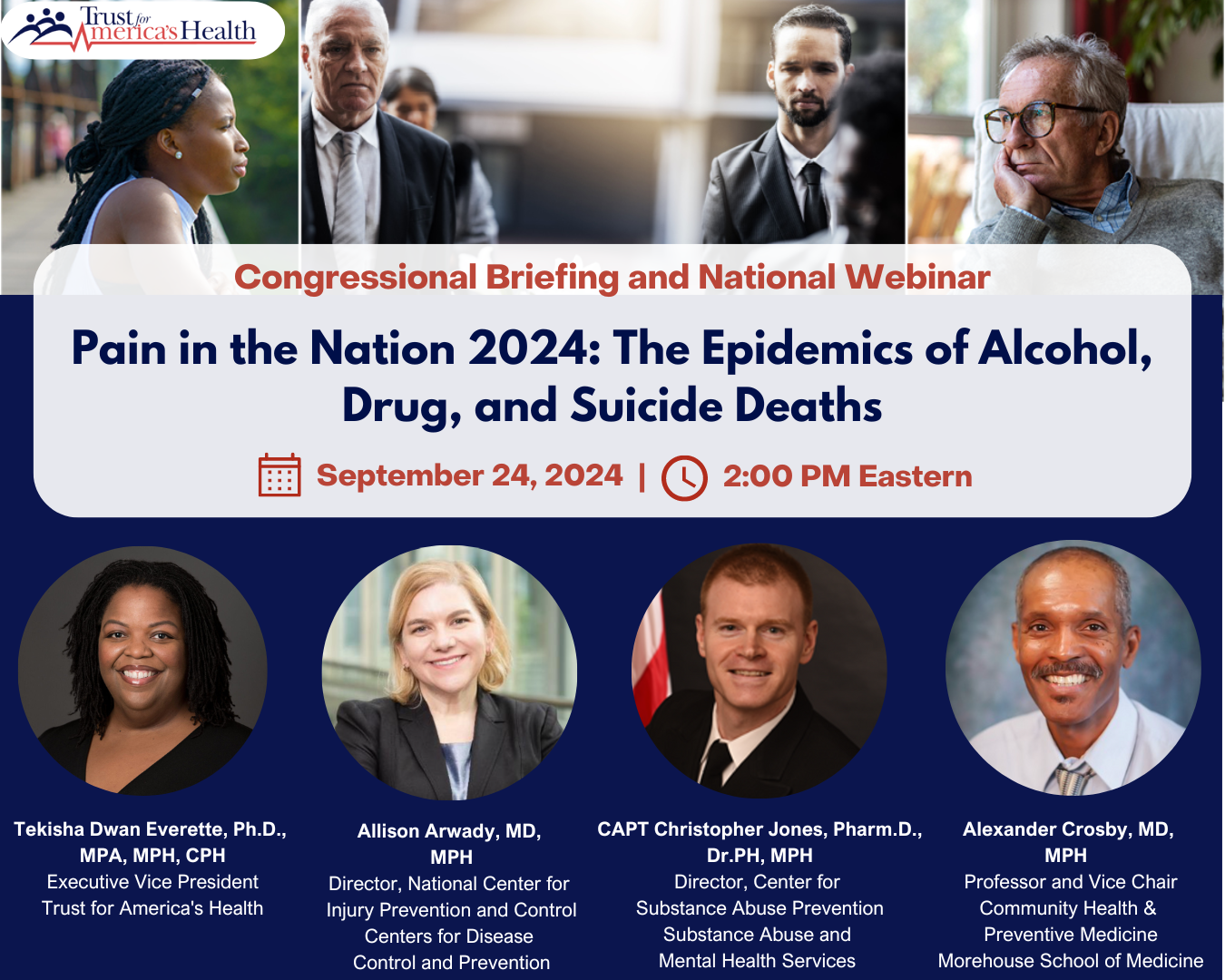
Trust for America’s Health’s (TFAH) held a national briefing of its latest milestone report: Pathway to a Healthier America: A Blueprint for Strengthening Public Health for the Next Administration and Congress. A recording of the briefing, which was held at the National Press Club in Washington, DC will be available soon.
Public health sits at an inflection point. Despite its critical role in saving lives and protecting our communities from 21st century threats, public health is at risk. Regardless of the outcome of the November election, the next Administration and Congress have the opportunity to strengthen public health and create a more resilient nation.
TFAH’s Blueprint is a roadmap for policymakers that, if adopted, will safeguard the nation’s health security, promote wellness, and above all, save lives. The event featured highlights from the report as well as engaging conversations with our speakers.
Blueprint Discussions
The Path Forward for Our Nation’s Health and Health Security
- The Honorable Michael O. Leavitt, 20th Secretary of Health and Human Services (2005 to 2009) and former Governor of Utah
- The Honorable Kathleen Sebelius, 21st Secretary of Health and Human Services (2009 to 2014) and former Governor of Kansas
Promoting Health and Saving Lives: Supporting Public Health on the Frontlines
- Frederick P. Cerise, M.D., MPH, President and Chief Executive Officer, Parkland Health
- Susan Kansagra, M.D., MBA, Former North Carolina State Health Officer and Assistant Secretary for Public Health, North Carolina Department of Health and Human Services
- Anand Parekh, M.D., MPH, Chief Medical Advisor, Bipartisan Policy Center and former Deputy Assistant Secretary for Health, U.S. Department of Health and Human Services

Trust for America’s Health (TFAH) hosted a national webinar on our report, Pain in the Nation 2024: The Epidemics of Alcohol, Drug, and Suicide Deaths.
TFAH’s report found that a decrease in the alcohol-induced mortality rate led to a slightly lower combined rate of all U.S. deaths due to alcohol, drugs, and suicide in 2022, but the long-term trend of such deaths is still alarmingly high. Between 2002 and 2022, combined deaths due to alcohol, drugs, and suicide have increased by 142 percent from 74,003 deaths in 2002 to 207,827 deaths in 2022. For 2022, the alcohol-induced mortality rate decreased by six percent to 13.5 deaths per 100,000 people, the first decrease in the rate after more than a decade of increases, but death rates for drug overdose and suicide remained unchanged. The report also includes a special feature on polysubstance misuse and overdose.
The webinar discussed steps policymakers should take to begin to reverse these crises.

Trust for America’s Health hosted a virtual Congressional briefing and national webinar honoring the 25th anniversary of the Centers for Disease Control and Prevention (CDC) Racial and Ethnic Approaches to Community Health (REACH) program. REACH aims to improve health, prevent chronic diseases, and reduce health disparities among racial and ethnic populations with the highest risk, or burden of chronic disease. Since 1999, the program has empowered communities to develop and share effective solutions, fostering a healthier future for all.
A panel of subject matter experts discussed the history, achievements, and future of the REACH program.

The Ready or Not 2024: Protecting the Public’s Health from Diseases, Disasters, and Bioterrorism report identifies gaps in national and state preparedness to protect residents’ health during emergencies and makes recommendations to strengthen the nation’s public health system and improve emergency readiness. As the nation experiences an increasing number of infectious disease outbreaks and extreme weather events, the report found that while emergency preparedness has improved in some areas, policymakers not heeding the lessons of past emergencies, funding cuts, and health misinformation put decades of progress at risk.
Resource:
Ready or Not 2024: State-by-State Factsheets

A person’s economic well-being can be a driver of their mental and physical health, while an individual’s overall health status can affect their income and economic well-being. One example of how overall health and economic well-being are connected was the COVID-19 pandemic, as people in the United States simultaneously experienced health and economic crises. While current unemployment rates are among historic lows, the uneven economic recovery spotlights the degree to which household financial security remains fragile in America, particularly along racial and socioeconomic divides. States are uniquely positioned to take action to fill gaps in the economic security safety net and adopt innovative solutions to help communities thrive.
A panel of subject experts discussed the impact of COVID-19 pandemic financial assistance programs and opportunities to enact evidence-based policies to further address the economic needs of communities, improve their financial stability, and promote their health and well-being.
Resources




